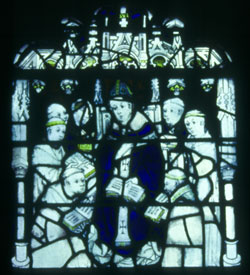 |
 |
 |
 |
 |
 |
 |
|
Cistercians in a changing world: Cistercians in public life (2/5) |
|
In the twelfth century there were two Cistercian archbishops: after a disputed election, Baldwin of Ford was consecrated archbishop of Canterbury in 1184; Henry Murdac, the dynamic abbot of Fountains, was elevated to the see of York in 1147.Murdac’s consecration came at the end of a long and controversial campaign, in which the Cistercians played a decisive role in the deposition of King Stephen’s candidate, William Fitzherbert. Fitzherbert was accused of simony (buying his way into office) and disreputable living, and in 1147 he was deposed by the Cistercian pope, Eugenius III, and replaced by Murdac. Stephen refused to invest the new archbishop, who was the first diocesan since 1066 to be appointed without royal assent. The publicity of this case heightened the Cistercians’ profile, depicting them as ardent reformers, who were committed to quashing corruption. |
|
